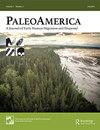Does the evidence at Arroyo del Vizcaíno (Uruguay) support the claim of human occupation 30,000 years ago?
IF 1.7
Q1 ANTHROPOLOGY
引用次数: 2
Abstract
ABSTRACT Researchers at Arroyo del Vizcaíno (AdV), Uruguay, have argued that human occupation dates prior to the Last Glacial Maximum (33,000–31,000 cal BP) based on the presence of purported stone tools and cutmarks on bones. We provide a summary of their research and critically evaluate these claims. We conclude that the claims of a pre-LGM occupation at AdV are unsupported due to: (1) equivocal evidence that the purported stone tools are culturally modified; (2) insufficiently documented spatial and contextual information; (3) inadequate geological research leading to an unconvincing site formation model; and (4) inadequate testing of alternative hypotheses for bones with surface modifications. We conclude that the site is best interpreted as a natural time-transgressive accumulation of mammal bones and other organic and inorganic materials within a fluvial setting spanning four millennia, and that bone surface modifications are the product of natural site formation processes rather than human agency.Arroyo del Vizcaíno(乌拉圭)的证据是否支持30000年前人类占领的说法?
乌拉圭阿罗约德尔Vizcaíno (AdV)的研究人员认为,根据据称存在的石器和骨头上的刻印,人类的居住时间早于末次冰期高峰(33000 - 31000 cal BP)。我们提供了他们的研究总结和批判性地评估这些说法。我们的结论是,关于lgm之前在AdV被占领的说法是不支持的,因为:(1)有模棱两可的证据表明,所谓的石器工具在文化上经过了修改;(2)空间和语境信息文件不足;(3)地质研究不足导致遗址形成模型不可信;(4)对具有表面修饰的骨骼的替代假设的测试不足。我们得出的结论是,该遗址最好被解释为一个跨越4000年的河流环境中哺乳动物骨骼和其他有机和无机材料的自然时间-海侵积累,并且骨骼表面的变化是自然遗址形成过程的产物,而不是人为作用的产物。
本文章由计算机程序翻译,如有差异,请以英文原文为准。
求助全文
约1分钟内获得全文
求助全文
来源期刊

PaleoAmerica
Earth and Planetary Sciences-Paleontology
CiteScore
3.70
自引率
0.00%
发文量
15
期刊介绍:
PaleoAmerica disseminates new research results and ideas about early human dispersal and migrations, with a particular focus on the Americas. It fosters an interdisciplinary dialog between archaeologists, geneticists and other scientists investigating the dispersal of modern humans during the late Pleistocene. The journal has three goals: First and foremost, the journal is a vehicle for the presentation of new research results. Second, it includes editorials on special topics written by leaders in the field. Third, the journal solicits essays covering current debates in the field, the state of research in relevant disciplines, and summaries of new research findings in a particular region, for example Beringia, the Eastern Seaboard or the Southern Cone of South America. Although the journal’s focus is the peopling of the Americas, editorials and research essays also highlight the investigation of early human colonization of empty lands in other areas of the world. As techniques are developing so rapidly, work in other regions can be very relevant to the Americas, so the journal will publish research relating to other regions which has relevance to research on the Americas.
 求助内容:
求助内容: 应助结果提醒方式:
应助结果提醒方式:


